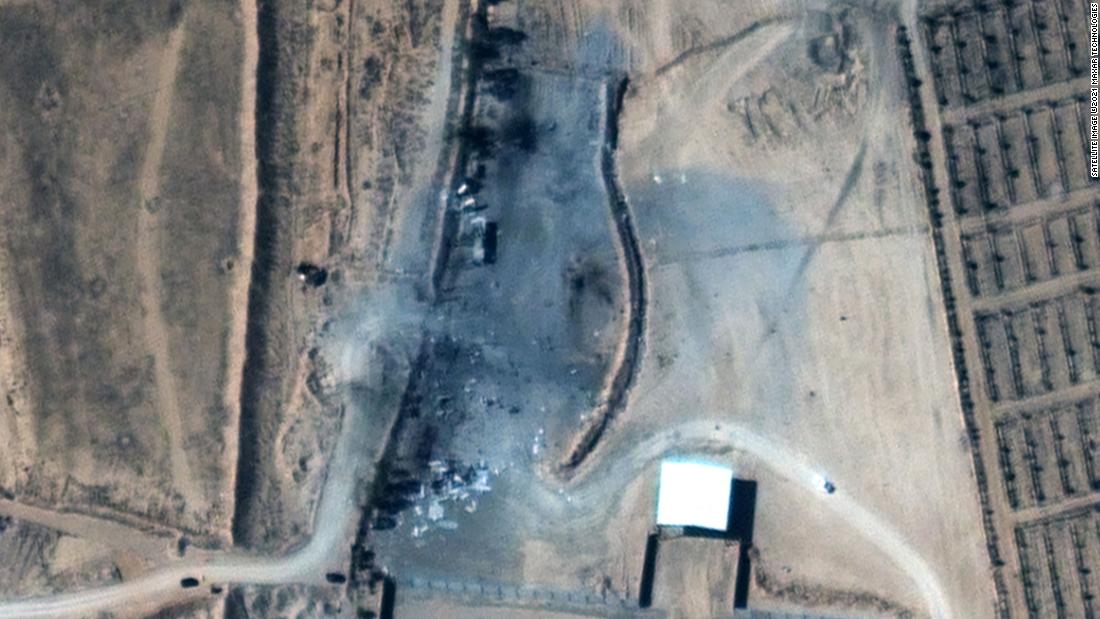What he probably heard was the sound of seven 500-pound bombs hitting a complex near the border. The complex, according to the Pentagon, was used by two Iraqi militias affiliated with Iran, Kata’ib Hezbollah and Kata’ib Sayyid Al-Shuhada.
Satellite images from before and after released by Maxar Technologies, a space technology company, vividly show how much destruction these bombs have caused.
The “before” image shows a complex, just over a third of a kilometer (about 370 yards) from the Iraqi border, containing about a dozen buildings of various sizes. In the “after” image, almost all of the buildings were destroyed, and the dirt inside and around the complex was darkened by the explosions.
It is not clear how many militia members were killed. Kata’ib Hezbollah recognized only one dead, without specifying where he died on the border between Iraq and Syria. A US official said that “even a handful” were killed, while other reports claim that between 17 and 22 people died.
The Pentagon says the attack was planned as a US response to a series of recent rocket and mortar attacks against US and coalition positions in Iraq. On February 15, a volley of rockets crashed on the ground at Erbil international airport and in residential areas of the city, killing a contractor and injuring several US military and Iraqi civilians. The Green Zone in Baghdad, where the American Embassy is located, has been a regular target for mortars and rockets. Kata’ib Hezbollah has repeatedly denied any involvement in these attacks, and has done so again in a statement released on Friday.
Pentagon officials told CNN that the targeting complex was unrelated to these attacks, but Defense Secretary Lloyd Austin said he was “confident” that it was used by the same militias that were targeting US and coalition forces in Iraq with attacks. of rockets.
The armed groups that allegedly use it, Kata’ib Hezbollah and Kata’ib Sayyid Al-Shuhada, are just two of a myriad of militias that gained prominence during the war against ISIS in Syria and Iraq, filling the void left by one Iraqi army that was in full retreat.
I spent a lot of time in 2015 and 2016 with some of these militias as they struggled to get from Baghdad to the north. Some were well organized and disciplined, others radical and volatile.
Its commanders were never intimidated by the support they received from Iran.
“Yes, we declare to the world, we have Iranian advisers,” Hadi Al-Amari, a senior commander of Iraq’s pro-Iranian Badr Brigades, told me in 2015 on the front lines outside the city of Tikrit, then under ISIS control. “We are proud of them and we are deeply grateful for participating with us.”
Nearby, I met an Iranian in combat uniform, who told me in incomplete Arabic that he was a volunteer.
A militia commander told me at the time that “it was better to have four Iranian advisers on the front line than 400 American advisers sitting in Baghdad’s Green Zone.”
Since then, Iranian-backed Iraqi militias have become increasingly powerful, while relations between Washington and Tehran have deteriorated dramatically.
Now the United States is in a situation where it hopes to make it clear that it will no longer tolerate attacks by Iranian-supported militias in its positions in Iraq, but at the same time it wants to reopen the dialogue with Iran. trying to build up to Tehran will not be an easy task.
Friday’s attack was the first known military action taken by the Biden government, making it the seventh consecutive U.S. government to use military force in the Middle East.
Administrations arrive in Washington. The administrations in Washington go. Some things, however, never change.
